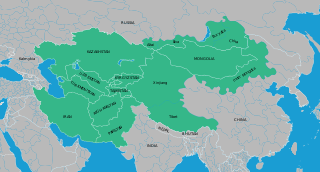Related Research Articles

Central Asia is a region of Asia bounded by the Caspian Sea to the southwest, European Russia to the northwest, China and Mongolia to the east, Afghanistan and Iran to the south, and Siberia to the north. It includes Kazakhstan, Kyrgyzstan, Tajikistan, Turkmenistan, and Uzbekistan. The countries as a group are also colloquially referred to as the "-stans" as all have names ending with the Persian suffix "-stan" in both respective native languages and most other languages.

The Uzbeks are a Turkic ethnic group native to Central Asia, being among the largest Turkic ethnic groups in the area. They comprise the majority population of Uzbekistan, next to Kazakh and Karakalpak minorities, and also form minority groups in Afghanistan, Tajikistan, Kyrgyzstan, Kazakhstan, Turkmenistan, Russia, and China. Uzbek diaspora communities also exist in Turkey, Saudi Arabia, United States, Ukraine, Pakistan, and other countries.

The Turkic peoples are a collection of diverse ethnic groups of West, Central, East, and North Asia as well as parts of Europe, who speak Turkic languages.

The Kyrgyz people are a Turkic ethnic group native to Central Asia. They primarily reside in Kyrgyzstan, Uzbekistan, and China. A Kyrgyz diaspora is also found in Russia, Tajikistan, and Kazakhstan. They speak the Kyrgyz language, which is the official language of Kyrgyzstan.

East Turkestan or East Turkistan, also called Uyghuristan, is a loosely-defined geographical region in the northwestern part of the People's Republic of China, which varies in meaning by context and usage. The term was coined in the 19th century by Russian Turkologists, including Nikita Bichurin, who intended the name to replace the common Western term for the region, "Chinese Turkestan", which referred to the Tarim Basin in Southern Xinjiang or Xinjiang as a whole during the Qing dynasty. Beginning in the 17th century, Altishahr, which means "Six Cities" in Uyghur, became the Uyghur name for the Tarim Basin. Uyghurs also called the Tarim Basin "Yettishar," which means "Seven Cities," and even "Sekkizshahr", which means "Eight Cities" in Uyghur. Chinese dynasties from the Han dynasty to the Tang dynasty had called an overlapping area the "Western Regions".

Turkology is a complex of humanities sciences studying languages, history, literature, folklore, culture, and ethnology of people speaking Turkic languages and the Turkic peoples in chronological and comparative context. That includes ethnic groups from the Sakha, in eastern Siberia, to the Turks in the Balkans and the Gagauz, in Moldova.

Inner Asia refers to the northern and landlocked regions spanning North, Central and East Asia. It includes parts of western and northeast China, as well as southern Siberia. The area overlaps with some definitions of "Central Asia", mostly the historical ones, but certain regions that are often included in Inner Asia, such as Manchuria, are not a part of Central Asia by any of its definitions. Inner Asia may be regarded as the western and northern "frontier" of China proper and as being bounded by East Asia proper, which consists of China proper, Japan and Korea.

The Chuvash people are a Turkic ethnic group, a branch of the Ogurs, inhabiting an area stretching from the Idel-Ural (Volga-Ural) region to Siberia.

Turanism, also known as pan-Turanism or pan-Turanianism, is a pan-nationalist political movement built around pseudoscientific claims of biological and linguistic connections between various ethnic groups of Eurasia. It revolves around the abandoned proposal of a Ural-Altaic language family, which hypothesizes that the Turkic, Mongolic, Tungusic, and Uralic peoples share Inner and Central Asian origins and therefore close cultural, ethnic, and linguistic bonds. Supporters of Turanism propose political unity among these groups, chiefly to oppose the cultural and political influences of the Indo-Europeans of Europe and South Asia, as well as the Sino-Tibetans of East Asia. The movement emerged in the 19th century to counter pan-nationalist ideologies such as pan-Germanism, and built upon the ideas of pan-Slavism.

Eurasian nomads form groups of nomadic peoples who have lived in various areas of the Eurasian Steppe. History largely knows them via frontier historical sources from Europe and Asia.

Peter Benjamin Golden is an American professor emeritus of History, Turkish and Middle Eastern Studies at Rutgers University. He has written many books and articles on Turkic and Central Asian studies, such as An introduction to the history of the Turkic peoples.

Yuri Enohovich Bregel was one of the world's leading historians of Islamic Central Asia. He published extensively on Persian- and Turkic-language history and historiography, and on political, economic and ethnic history in Central Asia and the Muslim world. He lived in the Soviet Union (1925–1974), Israel (1974–1981), and the United States (1981–2016).
Devin Deweese is a professor of Islamic and Central Eurasian Studies at Indiana University Bloomington, Indiana.

Nicholas N. Poppe was an important Russian linguist. He is also known as Nikolaus Poppe, with his first name in its German form. He is often cited as N.N. Poppe in academic publications.
The Department of Central Eurasian Studies, often abbreviated as CEUS, is a specialized academic department in the Hamilton Lugar School of Global and International Studies, at the Bloomington campus of Indiana University, in Bloomington, Indiana. Since its original formation in 1943 as a language-training program for the U.S. military, the department has become the sole independent degree-granting academic unit staffed with its own faculty dedicated to Central Eurasia in the country. Due to the department and the presence of several additional centers - the Inner Asian & Uralic National Resource Center, the Denis Sinor Research Institute for Inner Asian Studies, and the Center for Languages of the Central Asian Region - Indiana University currently hosts the premier program of Central Asian studies in the United States.
The International MA in Russian and Eurasian Studies is an advanced graduate programme at the European University at St. Petersburg, Russia, for students who already hold a BA degree or its equivalent. The programme is taught in English and offers training and research opportunities as well as a first hand experience of getting a close feel for Russia and many other countries in a wider region. In 1997 this programme began as MA in Russian Studies.

The L. N. Gumilev Eurasian National University (ENU), is a Kazakh national research university, and the largest higher education institution in Astana.
Mongolian studies or Mongolistics is an interdisciplinary field of scholarly inquiry concerning Mongolian language, Mongolian history, and Mongolian culture. Scholars who work in the field of Mongolian studies are often referred to as Mongolists.
References
- ↑ Levi 2012, p. 867.
- ↑ Levi 2012, p. 866.
- ↑ "Mizan: incorporating Central Asian review". OPC4. Archived from the original on 2007-09-27. Retrieved 2006-06-21.
- ↑ Will Myer. Islam and Colonialism: Western Perspective on Soviet Asia. London: RoutledgeCurzon, 2002. p. 103-4. ISBN 0-7007-1765-X.